An Analysis of Marketing and Operations: Toyota Corolla
VerifiedAdded on 2020/05/28
|13
|3564
|47
Report
AI Summary
This report provides a comprehensive analysis of the marketing and operations of the Toyota Corolla. It begins with an introduction to Toyota Motor Corporation and its renowned quality and service. The report is divided into three key elements: integration, marketing, and operations. The integration section explores customer opinions through a survey, highlighting the alignment of expectations and service delivery. The marketing section delves into the product life cycle, PEST analysis (political, economic, social, and technological factors), and SWOT analysis (strengths, weaknesses, opportunities, and threats) of the Toyota Corolla. The operations section examines the application of Just-in-Time (JIT) manufacturing. The report concludes with a summary of findings and references.
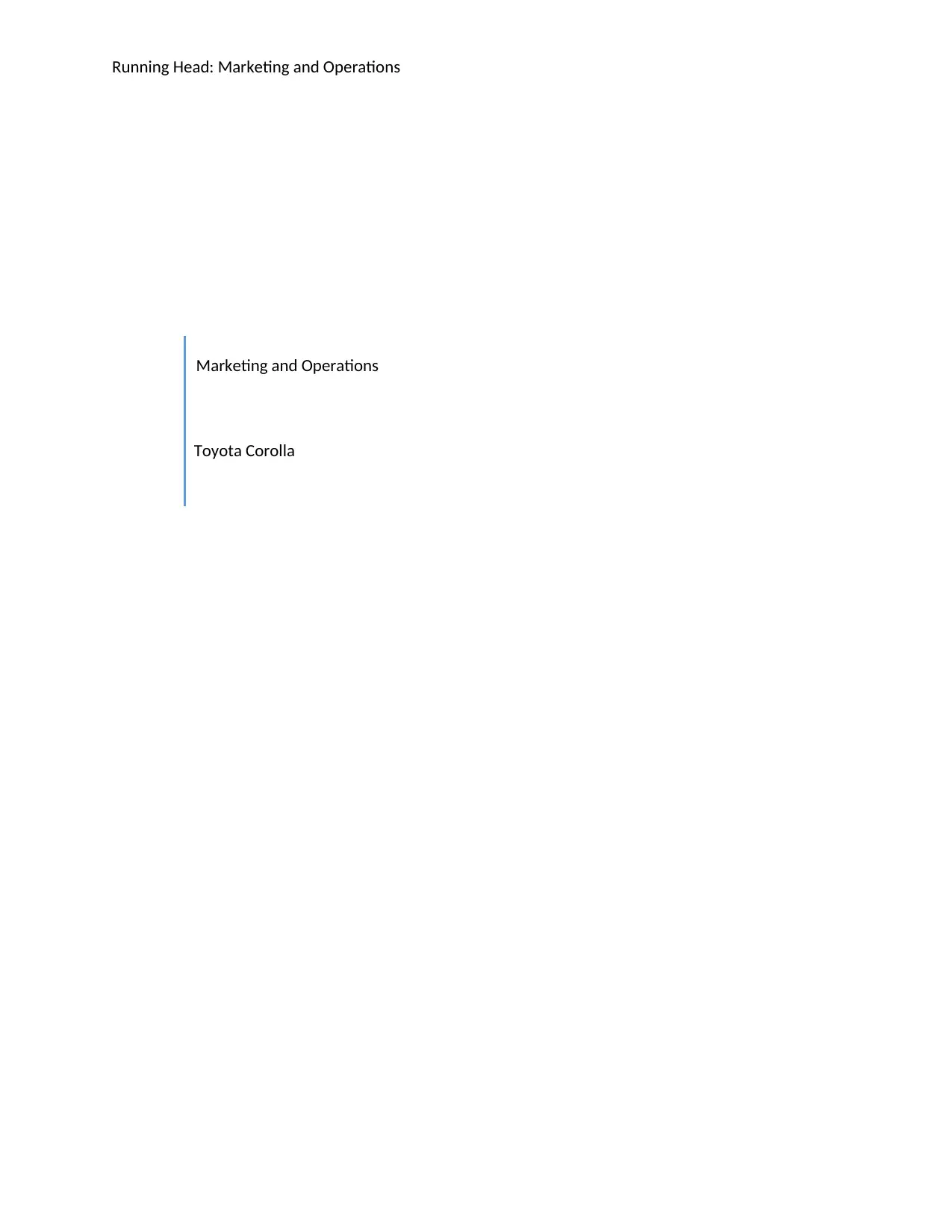
Running Head: Marketing and Operations
Marketing and Operations
Toyota Corolla
Marketing and Operations
Toyota Corolla
Paraphrase This Document
Need a fresh take? Get an instant paraphrase of this document with our AI Paraphraser
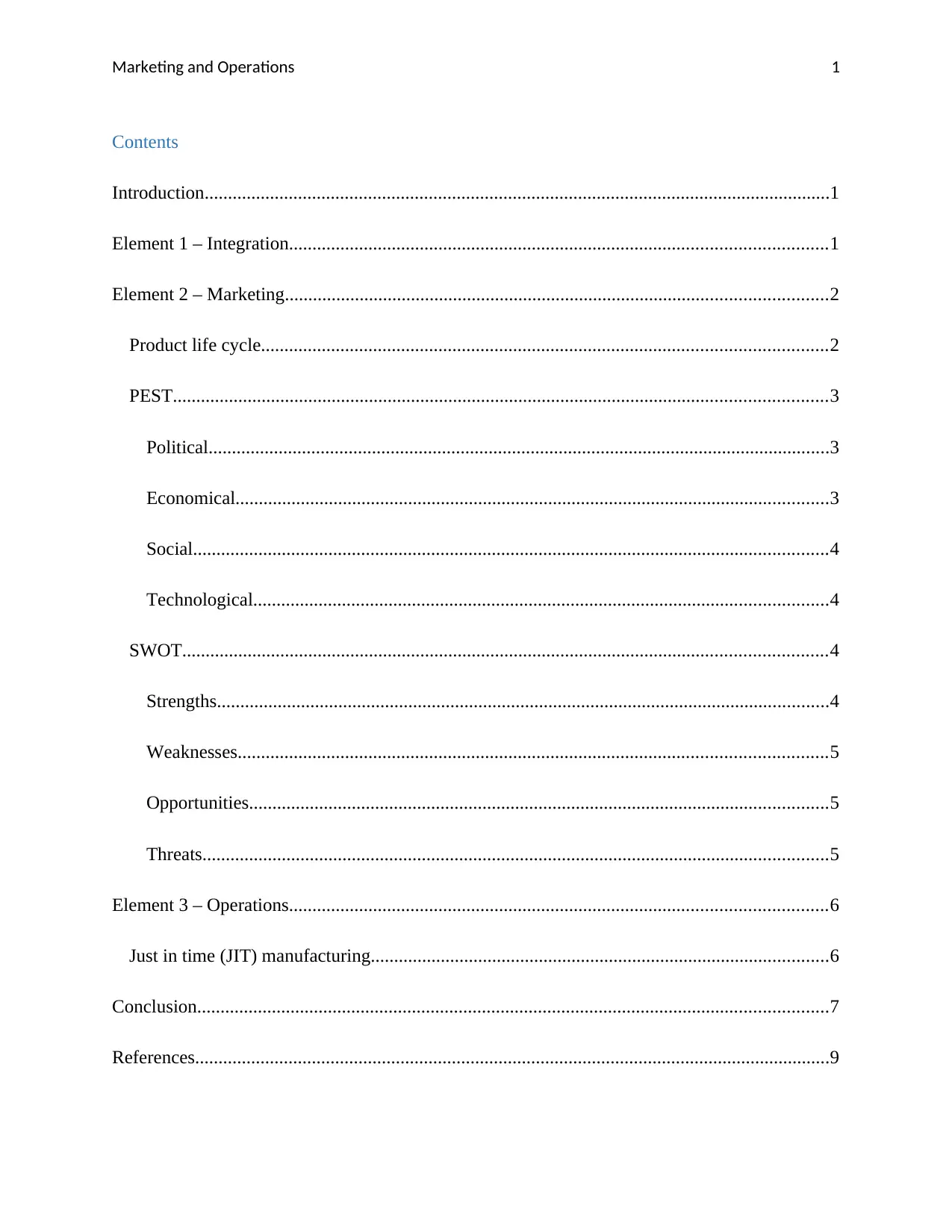
Marketing and Operations 1
Contents
Introduction......................................................................................................................................1
Element 1 – Integration...................................................................................................................1
Element 2 – Marketing....................................................................................................................2
Product life cycle.........................................................................................................................2
PEST............................................................................................................................................3
Political.....................................................................................................................................3
Economical...............................................................................................................................3
Social........................................................................................................................................4
Technological...........................................................................................................................4
SWOT..........................................................................................................................................4
Strengths...................................................................................................................................4
Weaknesses..............................................................................................................................5
Opportunities............................................................................................................................5
Threats......................................................................................................................................5
Element 3 – Operations...................................................................................................................6
Just in time (JIT) manufacturing..................................................................................................6
Conclusion.......................................................................................................................................7
References........................................................................................................................................9
Contents
Introduction......................................................................................................................................1
Element 1 – Integration...................................................................................................................1
Element 2 – Marketing....................................................................................................................2
Product life cycle.........................................................................................................................2
PEST............................................................................................................................................3
Political.....................................................................................................................................3
Economical...............................................................................................................................3
Social........................................................................................................................................4
Technological...........................................................................................................................4
SWOT..........................................................................................................................................4
Strengths...................................................................................................................................4
Weaknesses..............................................................................................................................5
Opportunities............................................................................................................................5
Threats......................................................................................................................................5
Element 3 – Operations...................................................................................................................6
Just in time (JIT) manufacturing..................................................................................................6
Conclusion.......................................................................................................................................7
References........................................................................................................................................9
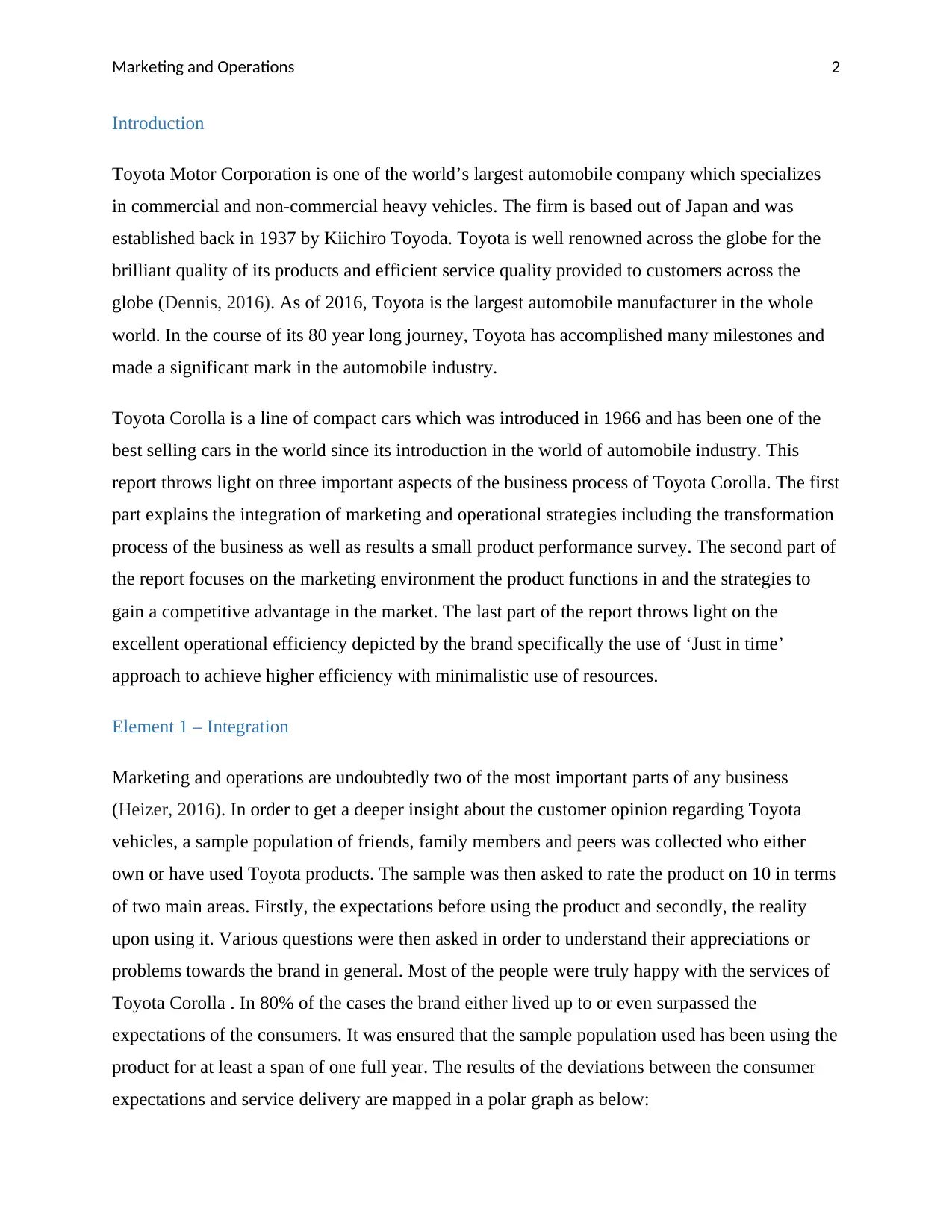
Marketing and Operations 2
Introduction
Toyota Motor Corporation is one of the world’s largest automobile company which specializes
in commercial and non-commercial heavy vehicles. The firm is based out of Japan and was
established back in 1937 by Kiichiro Toyoda. Toyota is well renowned across the globe for the
brilliant quality of its products and efficient service quality provided to customers across the
globe (Dennis, 2016). As of 2016, Toyota is the largest automobile manufacturer in the whole
world. In the course of its 80 year long journey, Toyota has accomplished many milestones and
made a significant mark in the automobile industry.
Toyota Corolla is a line of compact cars which was introduced in 1966 and has been one of the
best selling cars in the world since its introduction in the world of automobile industry. This
report throws light on three important aspects of the business process of Toyota Corolla. The first
part explains the integration of marketing and operational strategies including the transformation
process of the business as well as results a small product performance survey. The second part of
the report focuses on the marketing environment the product functions in and the strategies to
gain a competitive advantage in the market. The last part of the report throws light on the
excellent operational efficiency depicted by the brand specifically the use of ‘Just in time’
approach to achieve higher efficiency with minimalistic use of resources.
Element 1 – Integration
Marketing and operations are undoubtedly two of the most important parts of any business
(Heizer, 2016). In order to get a deeper insight about the customer opinion regarding Toyota
vehicles, a sample population of friends, family members and peers was collected who either
own or have used Toyota products. The sample was then asked to rate the product on 10 in terms
of two main areas. Firstly, the expectations before using the product and secondly, the reality
upon using it. Various questions were then asked in order to understand their appreciations or
problems towards the brand in general. Most of the people were truly happy with the services of
Toyota Corolla . In 80% of the cases the brand either lived up to or even surpassed the
expectations of the consumers. It was ensured that the sample population used has been using the
product for at least a span of one full year. The results of the deviations between the consumer
expectations and service delivery are mapped in a polar graph as below:
Introduction
Toyota Motor Corporation is one of the world’s largest automobile company which specializes
in commercial and non-commercial heavy vehicles. The firm is based out of Japan and was
established back in 1937 by Kiichiro Toyoda. Toyota is well renowned across the globe for the
brilliant quality of its products and efficient service quality provided to customers across the
globe (Dennis, 2016). As of 2016, Toyota is the largest automobile manufacturer in the whole
world. In the course of its 80 year long journey, Toyota has accomplished many milestones and
made a significant mark in the automobile industry.
Toyota Corolla is a line of compact cars which was introduced in 1966 and has been one of the
best selling cars in the world since its introduction in the world of automobile industry. This
report throws light on three important aspects of the business process of Toyota Corolla. The first
part explains the integration of marketing and operational strategies including the transformation
process of the business as well as results a small product performance survey. The second part of
the report focuses on the marketing environment the product functions in and the strategies to
gain a competitive advantage in the market. The last part of the report throws light on the
excellent operational efficiency depicted by the brand specifically the use of ‘Just in time’
approach to achieve higher efficiency with minimalistic use of resources.
Element 1 – Integration
Marketing and operations are undoubtedly two of the most important parts of any business
(Heizer, 2016). In order to get a deeper insight about the customer opinion regarding Toyota
vehicles, a sample population of friends, family members and peers was collected who either
own or have used Toyota products. The sample was then asked to rate the product on 10 in terms
of two main areas. Firstly, the expectations before using the product and secondly, the reality
upon using it. Various questions were then asked in order to understand their appreciations or
problems towards the brand in general. Most of the people were truly happy with the services of
Toyota Corolla . In 80% of the cases the brand either lived up to or even surpassed the
expectations of the consumers. It was ensured that the sample population used has been using the
product for at least a span of one full year. The results of the deviations between the consumer
expectations and service delivery are mapped in a polar graph as below:
⊘ This is a preview!⊘
Do you want full access?
Subscribe today to unlock all pages.

Trusted by 1+ million students worldwide
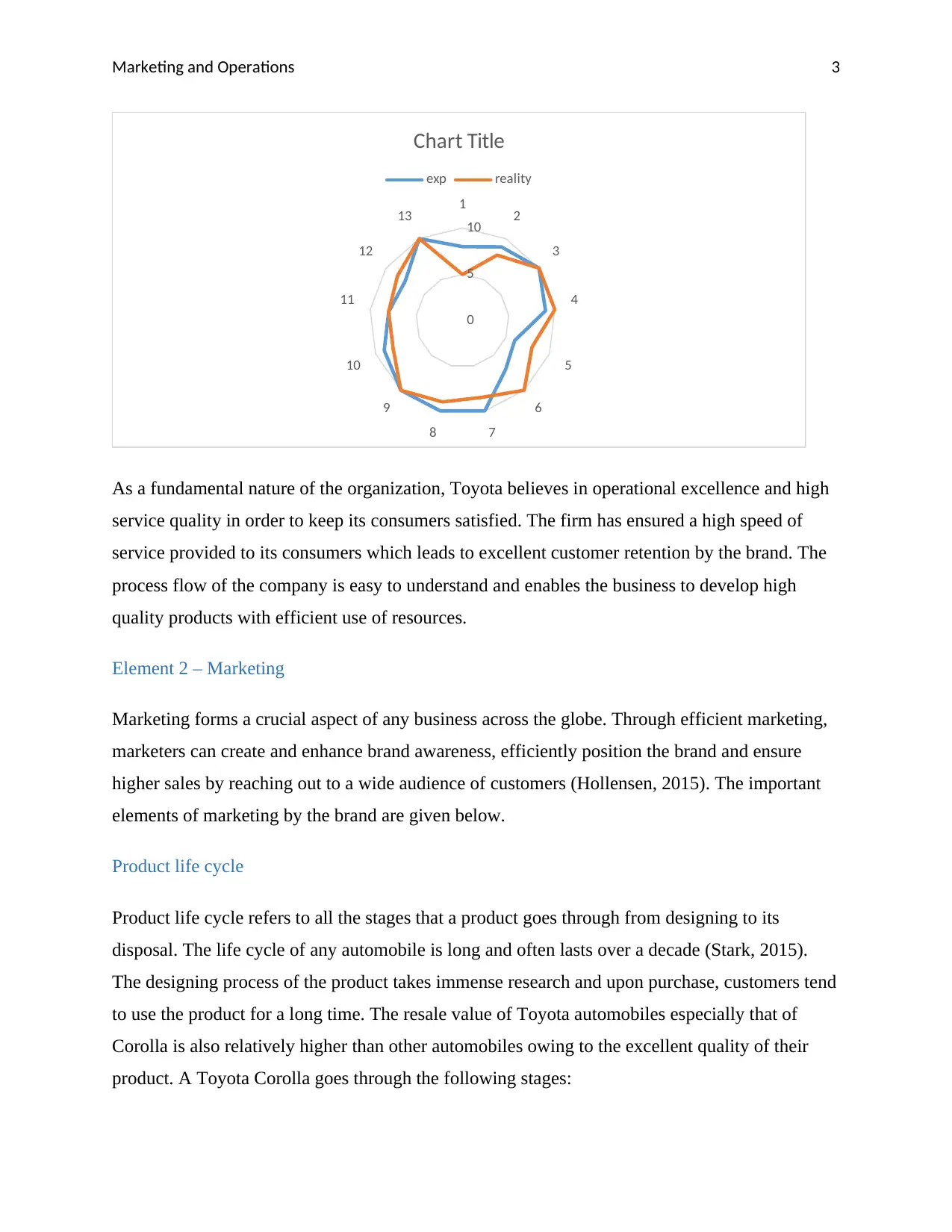
Marketing and Operations 3
1 2
3
4
5
6
78
9
10
11
12
13
0
5
10
Chart Title
exp reality
As a fundamental nature of the organization, Toyota believes in operational excellence and high
service quality in order to keep its consumers satisfied. The firm has ensured a high speed of
service provided to its consumers which leads to excellent customer retention by the brand. The
process flow of the company is easy to understand and enables the business to develop high
quality products with efficient use of resources.
Element 2 – Marketing
Marketing forms a crucial aspect of any business across the globe. Through efficient marketing,
marketers can create and enhance brand awareness, efficiently position the brand and ensure
higher sales by reaching out to a wide audience of customers (Hollensen, 2015). The important
elements of marketing by the brand are given below.
Product life cycle
Product life cycle refers to all the stages that a product goes through from designing to its
disposal. The life cycle of any automobile is long and often lasts over a decade (Stark, 2015).
The designing process of the product takes immense research and upon purchase, customers tend
to use the product for a long time. The resale value of Toyota automobiles especially that of
Corolla is also relatively higher than other automobiles owing to the excellent quality of their
product. A Toyota Corolla goes through the following stages:
1 2
3
4
5
6
78
9
10
11
12
13
0
5
10
Chart Title
exp reality
As a fundamental nature of the organization, Toyota believes in operational excellence and high
service quality in order to keep its consumers satisfied. The firm has ensured a high speed of
service provided to its consumers which leads to excellent customer retention by the brand. The
process flow of the company is easy to understand and enables the business to develop high
quality products with efficient use of resources.
Element 2 – Marketing
Marketing forms a crucial aspect of any business across the globe. Through efficient marketing,
marketers can create and enhance brand awareness, efficiently position the brand and ensure
higher sales by reaching out to a wide audience of customers (Hollensen, 2015). The important
elements of marketing by the brand are given below.
Product life cycle
Product life cycle refers to all the stages that a product goes through from designing to its
disposal. The life cycle of any automobile is long and often lasts over a decade (Stark, 2015).
The designing process of the product takes immense research and upon purchase, customers tend
to use the product for a long time. The resale value of Toyota automobiles especially that of
Corolla is also relatively higher than other automobiles owing to the excellent quality of their
product. A Toyota Corolla goes through the following stages:
Paraphrase This Document
Need a fresh take? Get an instant paraphrase of this document with our AI Paraphraser
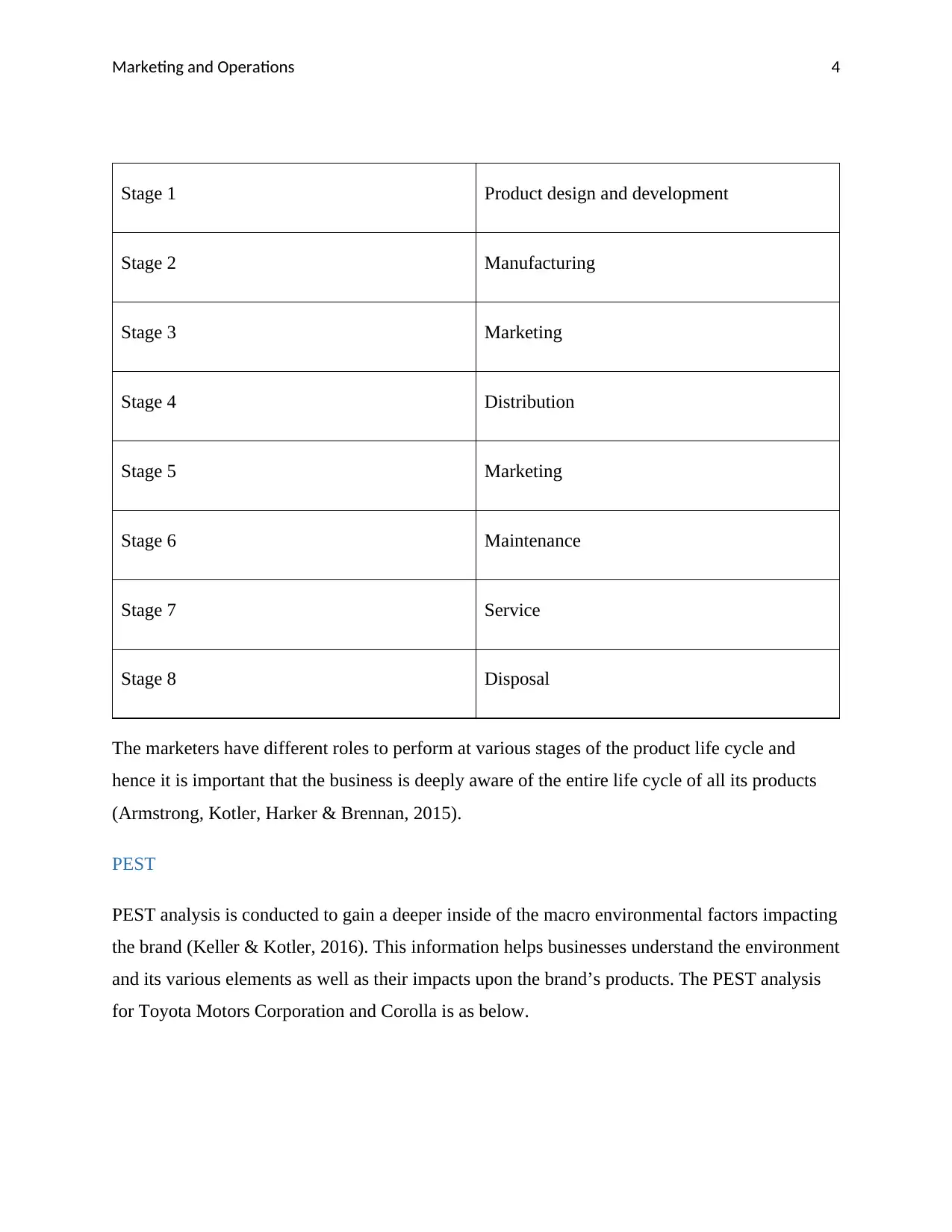
Marketing and Operations 4
Stage 1 Product design and development
Stage 2 Manufacturing
Stage 3 Marketing
Stage 4 Distribution
Stage 5 Marketing
Stage 6 Maintenance
Stage 7 Service
Stage 8 Disposal
The marketers have different roles to perform at various stages of the product life cycle and
hence it is important that the business is deeply aware of the entire life cycle of all its products
(Armstrong, Kotler, Harker & Brennan, 2015).
PEST
PEST analysis is conducted to gain a deeper inside of the macro environmental factors impacting
the brand (Keller & Kotler, 2016). This information helps businesses understand the environment
and its various elements as well as their impacts upon the brand’s products. The PEST analysis
for Toyota Motors Corporation and Corolla is as below.
Stage 1 Product design and development
Stage 2 Manufacturing
Stage 3 Marketing
Stage 4 Distribution
Stage 5 Marketing
Stage 6 Maintenance
Stage 7 Service
Stage 8 Disposal
The marketers have different roles to perform at various stages of the product life cycle and
hence it is important that the business is deeply aware of the entire life cycle of all its products
(Armstrong, Kotler, Harker & Brennan, 2015).
PEST
PEST analysis is conducted to gain a deeper inside of the macro environmental factors impacting
the brand (Keller & Kotler, 2016). This information helps businesses understand the environment
and its various elements as well as their impacts upon the brand’s products. The PEST analysis
for Toyota Motors Corporation and Corolla is as below.
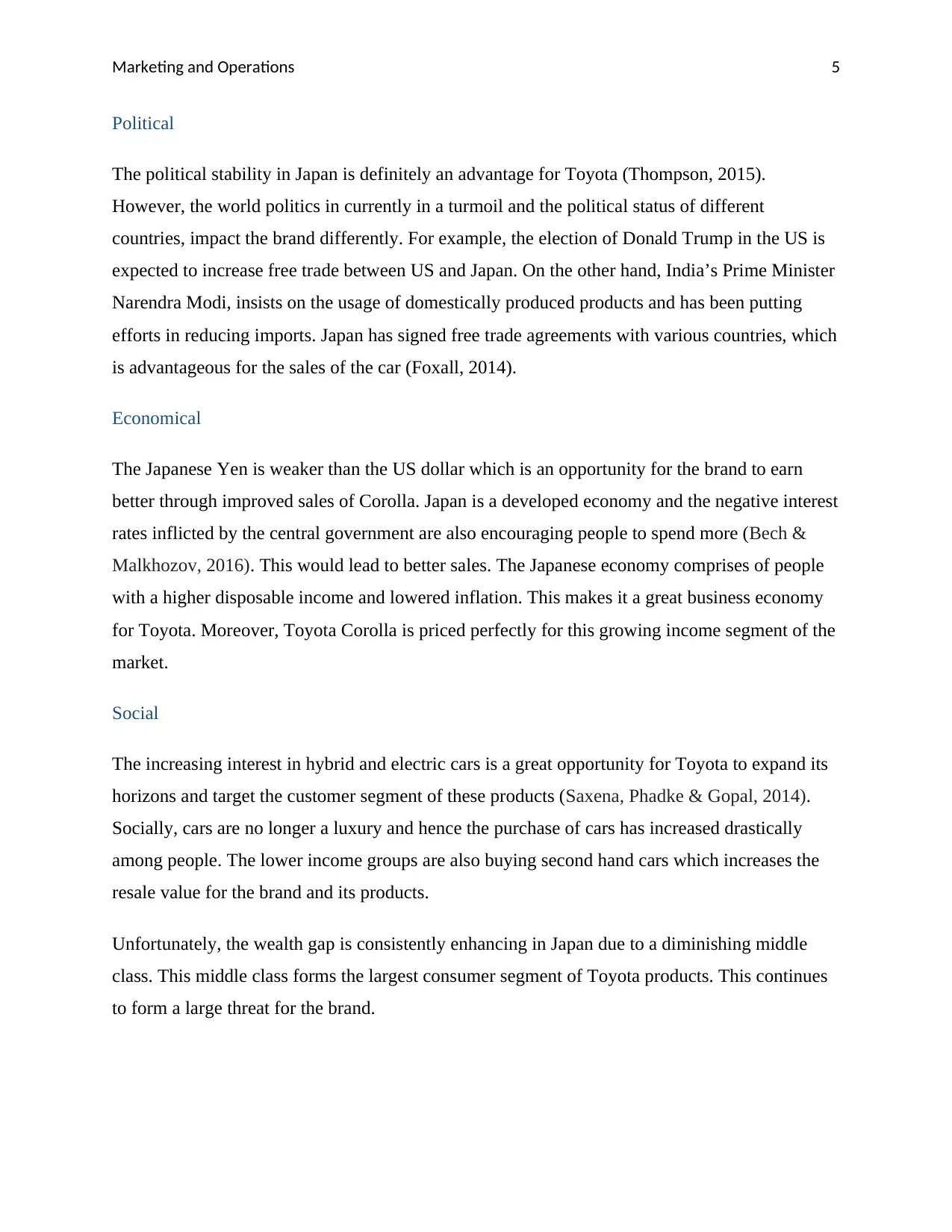
Marketing and Operations 5
Political
The political stability in Japan is definitely an advantage for Toyota (Thompson, 2015).
However, the world politics in currently in a turmoil and the political status of different
countries, impact the brand differently. For example, the election of Donald Trump in the US is
expected to increase free trade between US and Japan. On the other hand, India’s Prime Minister
Narendra Modi, insists on the usage of domestically produced products and has been putting
efforts in reducing imports. Japan has signed free trade agreements with various countries, which
is advantageous for the sales of the car (Foxall, 2014).
Economical
The Japanese Yen is weaker than the US dollar which is an opportunity for the brand to earn
better through improved sales of Corolla. Japan is a developed economy and the negative interest
rates inflicted by the central government are also encouraging people to spend more (Bech &
Malkhozov, 2016). This would lead to better sales. The Japanese economy comprises of people
with a higher disposable income and lowered inflation. This makes it a great business economy
for Toyota. Moreover, Toyota Corolla is priced perfectly for this growing income segment of the
market.
Social
The increasing interest in hybrid and electric cars is a great opportunity for Toyota to expand its
horizons and target the customer segment of these products (Saxena, Phadke & Gopal, 2014).
Socially, cars are no longer a luxury and hence the purchase of cars has increased drastically
among people. The lower income groups are also buying second hand cars which increases the
resale value for the brand and its products.
Unfortunately, the wealth gap is consistently enhancing in Japan due to a diminishing middle
class. This middle class forms the largest consumer segment of Toyota products. This continues
to form a large threat for the brand.
Political
The political stability in Japan is definitely an advantage for Toyota (Thompson, 2015).
However, the world politics in currently in a turmoil and the political status of different
countries, impact the brand differently. For example, the election of Donald Trump in the US is
expected to increase free trade between US and Japan. On the other hand, India’s Prime Minister
Narendra Modi, insists on the usage of domestically produced products and has been putting
efforts in reducing imports. Japan has signed free trade agreements with various countries, which
is advantageous for the sales of the car (Foxall, 2014).
Economical
The Japanese Yen is weaker than the US dollar which is an opportunity for the brand to earn
better through improved sales of Corolla. Japan is a developed economy and the negative interest
rates inflicted by the central government are also encouraging people to spend more (Bech &
Malkhozov, 2016). This would lead to better sales. The Japanese economy comprises of people
with a higher disposable income and lowered inflation. This makes it a great business economy
for Toyota. Moreover, Toyota Corolla is priced perfectly for this growing income segment of the
market.
Social
The increasing interest in hybrid and electric cars is a great opportunity for Toyota to expand its
horizons and target the customer segment of these products (Saxena, Phadke & Gopal, 2014).
Socially, cars are no longer a luxury and hence the purchase of cars has increased drastically
among people. The lower income groups are also buying second hand cars which increases the
resale value for the brand and its products.
Unfortunately, the wealth gap is consistently enhancing in Japan due to a diminishing middle
class. This middle class forms the largest consumer segment of Toyota products. This continues
to form a large threat for the brand.
⊘ This is a preview!⊘
Do you want full access?
Subscribe today to unlock all pages.

Trusted by 1+ million students worldwide
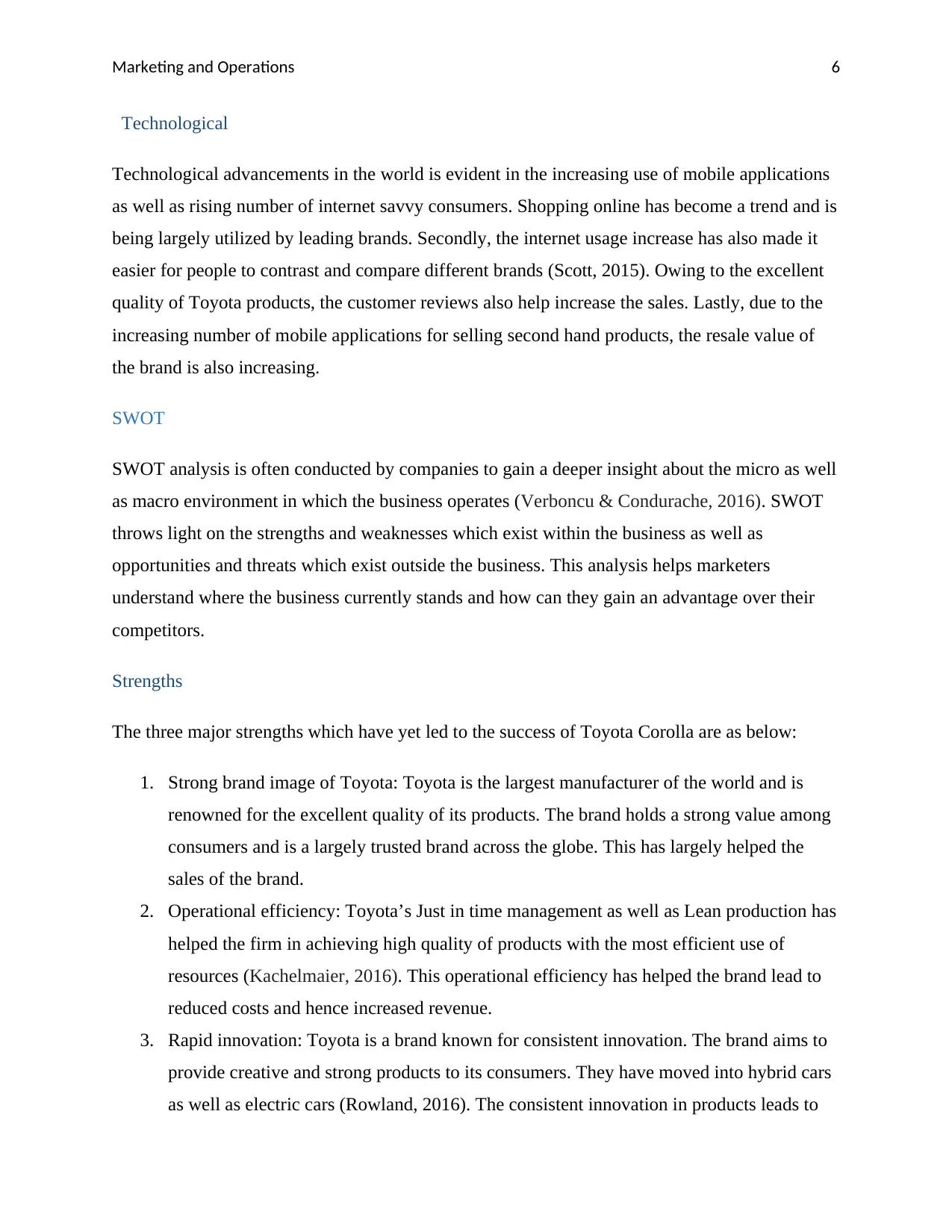
Marketing and Operations 6
Technological
Technological advancements in the world is evident in the increasing use of mobile applications
as well as rising number of internet savvy consumers. Shopping online has become a trend and is
being largely utilized by leading brands. Secondly, the internet usage increase has also made it
easier for people to contrast and compare different brands (Scott, 2015). Owing to the excellent
quality of Toyota products, the customer reviews also help increase the sales. Lastly, due to the
increasing number of mobile applications for selling second hand products, the resale value of
the brand is also increasing.
SWOT
SWOT analysis is often conducted by companies to gain a deeper insight about the micro as well
as macro environment in which the business operates (Verboncu & Condurache, 2016). SWOT
throws light on the strengths and weaknesses which exist within the business as well as
opportunities and threats which exist outside the business. This analysis helps marketers
understand where the business currently stands and how can they gain an advantage over their
competitors.
Strengths
The three major strengths which have yet led to the success of Toyota Corolla are as below:
1. Strong brand image of Toyota: Toyota is the largest manufacturer of the world and is
renowned for the excellent quality of its products. The brand holds a strong value among
consumers and is a largely trusted brand across the globe. This has largely helped the
sales of the brand.
2. Operational efficiency: Toyota’s Just in time management as well as Lean production has
helped the firm in achieving high quality of products with the most efficient use of
resources (Kachelmaier, 2016). This operational efficiency has helped the brand lead to
reduced costs and hence increased revenue.
3. Rapid innovation: Toyota is a brand known for consistent innovation. The brand aims to
provide creative and strong products to its consumers. They have moved into hybrid cars
as well as electric cars (Rowland, 2016). The consistent innovation in products leads to
Technological
Technological advancements in the world is evident in the increasing use of mobile applications
as well as rising number of internet savvy consumers. Shopping online has become a trend and is
being largely utilized by leading brands. Secondly, the internet usage increase has also made it
easier for people to contrast and compare different brands (Scott, 2015). Owing to the excellent
quality of Toyota products, the customer reviews also help increase the sales. Lastly, due to the
increasing number of mobile applications for selling second hand products, the resale value of
the brand is also increasing.
SWOT
SWOT analysis is often conducted by companies to gain a deeper insight about the micro as well
as macro environment in which the business operates (Verboncu & Condurache, 2016). SWOT
throws light on the strengths and weaknesses which exist within the business as well as
opportunities and threats which exist outside the business. This analysis helps marketers
understand where the business currently stands and how can they gain an advantage over their
competitors.
Strengths
The three major strengths which have yet led to the success of Toyota Corolla are as below:
1. Strong brand image of Toyota: Toyota is the largest manufacturer of the world and is
renowned for the excellent quality of its products. The brand holds a strong value among
consumers and is a largely trusted brand across the globe. This has largely helped the
sales of the brand.
2. Operational efficiency: Toyota’s Just in time management as well as Lean production has
helped the firm in achieving high quality of products with the most efficient use of
resources (Kachelmaier, 2016). This operational efficiency has helped the brand lead to
reduced costs and hence increased revenue.
3. Rapid innovation: Toyota is a brand known for consistent innovation. The brand aims to
provide creative and strong products to its consumers. They have moved into hybrid cars
as well as electric cars (Rowland, 2016). The consistent innovation in products leads to
Paraphrase This Document
Need a fresh take? Get an instant paraphrase of this document with our AI Paraphraser
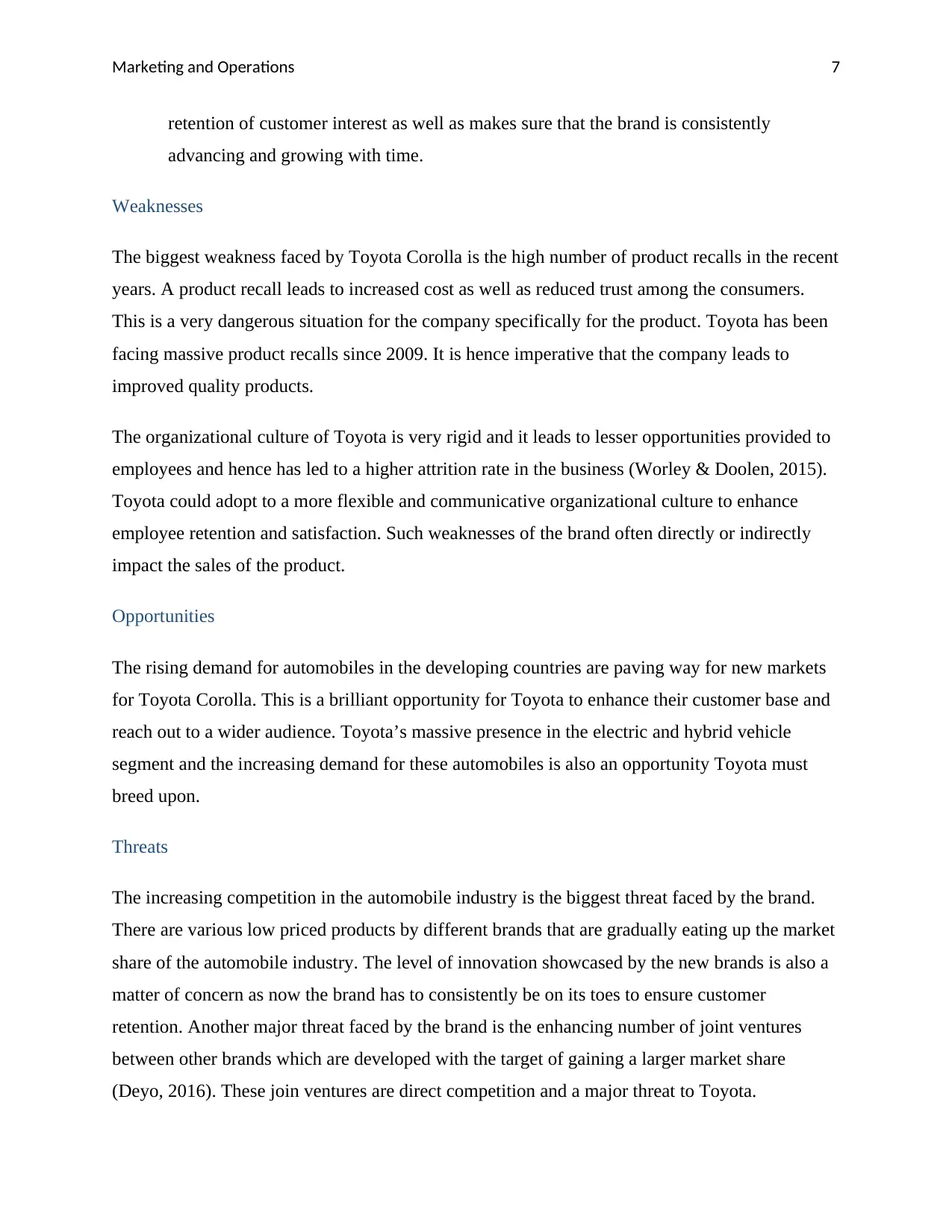
Marketing and Operations 7
retention of customer interest as well as makes sure that the brand is consistently
advancing and growing with time.
Weaknesses
The biggest weakness faced by Toyota Corolla is the high number of product recalls in the recent
years. A product recall leads to increased cost as well as reduced trust among the consumers.
This is a very dangerous situation for the company specifically for the product. Toyota has been
facing massive product recalls since 2009. It is hence imperative that the company leads to
improved quality products.
The organizational culture of Toyota is very rigid and it leads to lesser opportunities provided to
employees and hence has led to a higher attrition rate in the business (Worley & Doolen, 2015).
Toyota could adopt to a more flexible and communicative organizational culture to enhance
employee retention and satisfaction. Such weaknesses of the brand often directly or indirectly
impact the sales of the product.
Opportunities
The rising demand for automobiles in the developing countries are paving way for new markets
for Toyota Corolla. This is a brilliant opportunity for Toyota to enhance their customer base and
reach out to a wider audience. Toyota’s massive presence in the electric and hybrid vehicle
segment and the increasing demand for these automobiles is also an opportunity Toyota must
breed upon.
Threats
The increasing competition in the automobile industry is the biggest threat faced by the brand.
There are various low priced products by different brands that are gradually eating up the market
share of the automobile industry. The level of innovation showcased by the new brands is also a
matter of concern as now the brand has to consistently be on its toes to ensure customer
retention. Another major threat faced by the brand is the enhancing number of joint ventures
between other brands which are developed with the target of gaining a larger market share
(Deyo, 2016). These join ventures are direct competition and a major threat to Toyota.
retention of customer interest as well as makes sure that the brand is consistently
advancing and growing with time.
Weaknesses
The biggest weakness faced by Toyota Corolla is the high number of product recalls in the recent
years. A product recall leads to increased cost as well as reduced trust among the consumers.
This is a very dangerous situation for the company specifically for the product. Toyota has been
facing massive product recalls since 2009. It is hence imperative that the company leads to
improved quality products.
The organizational culture of Toyota is very rigid and it leads to lesser opportunities provided to
employees and hence has led to a higher attrition rate in the business (Worley & Doolen, 2015).
Toyota could adopt to a more flexible and communicative organizational culture to enhance
employee retention and satisfaction. Such weaknesses of the brand often directly or indirectly
impact the sales of the product.
Opportunities
The rising demand for automobiles in the developing countries are paving way for new markets
for Toyota Corolla. This is a brilliant opportunity for Toyota to enhance their customer base and
reach out to a wider audience. Toyota’s massive presence in the electric and hybrid vehicle
segment and the increasing demand for these automobiles is also an opportunity Toyota must
breed upon.
Threats
The increasing competition in the automobile industry is the biggest threat faced by the brand.
There are various low priced products by different brands that are gradually eating up the market
share of the automobile industry. The level of innovation showcased by the new brands is also a
matter of concern as now the brand has to consistently be on its toes to ensure customer
retention. Another major threat faced by the brand is the enhancing number of joint ventures
between other brands which are developed with the target of gaining a larger market share
(Deyo, 2016). These join ventures are direct competition and a major threat to Toyota.
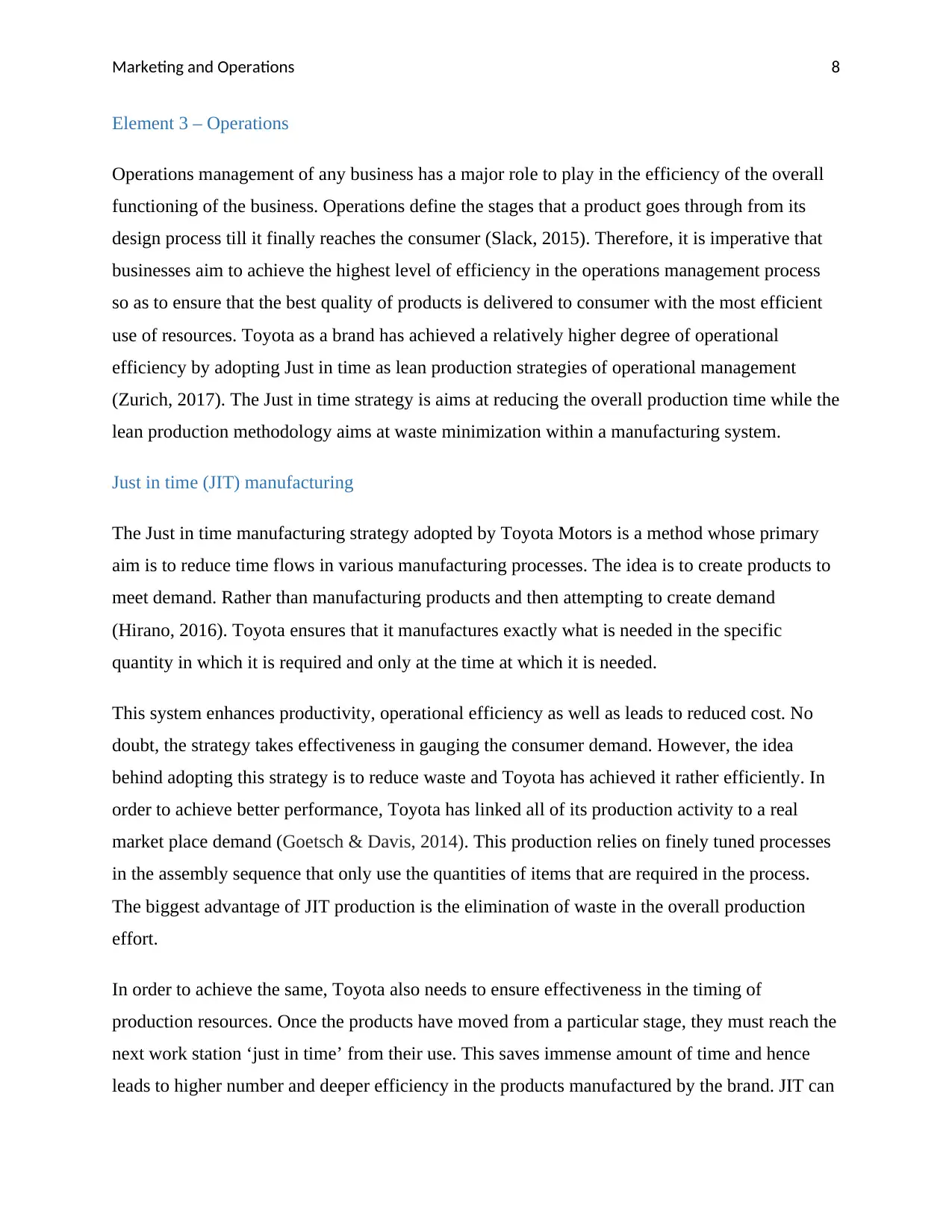
Marketing and Operations 8
Element 3 – Operations
Operations management of any business has a major role to play in the efficiency of the overall
functioning of the business. Operations define the stages that a product goes through from its
design process till it finally reaches the consumer (Slack, 2015). Therefore, it is imperative that
businesses aim to achieve the highest level of efficiency in the operations management process
so as to ensure that the best quality of products is delivered to consumer with the most efficient
use of resources. Toyota as a brand has achieved a relatively higher degree of operational
efficiency by adopting Just in time as lean production strategies of operational management
(Zurich, 2017). The Just in time strategy is aims at reducing the overall production time while the
lean production methodology aims at waste minimization within a manufacturing system.
Just in time (JIT) manufacturing
The Just in time manufacturing strategy adopted by Toyota Motors is a method whose primary
aim is to reduce time flows in various manufacturing processes. The idea is to create products to
meet demand. Rather than manufacturing products and then attempting to create demand
(Hirano, 2016). Toyota ensures that it manufactures exactly what is needed in the specific
quantity in which it is required and only at the time at which it is needed.
This system enhances productivity, operational efficiency as well as leads to reduced cost. No
doubt, the strategy takes effectiveness in gauging the consumer demand. However, the idea
behind adopting this strategy is to reduce waste and Toyota has achieved it rather efficiently. In
order to achieve better performance, Toyota has linked all of its production activity to a real
market place demand (Goetsch & Davis, 2014). This production relies on finely tuned processes
in the assembly sequence that only use the quantities of items that are required in the process.
The biggest advantage of JIT production is the elimination of waste in the overall production
effort.
In order to achieve the same, Toyota also needs to ensure effectiveness in the timing of
production resources. Once the products have moved from a particular stage, they must reach the
next work station ‘just in time’ from their use. This saves immense amount of time and hence
leads to higher number and deeper efficiency in the products manufactured by the brand. JIT can
Element 3 – Operations
Operations management of any business has a major role to play in the efficiency of the overall
functioning of the business. Operations define the stages that a product goes through from its
design process till it finally reaches the consumer (Slack, 2015). Therefore, it is imperative that
businesses aim to achieve the highest level of efficiency in the operations management process
so as to ensure that the best quality of products is delivered to consumer with the most efficient
use of resources. Toyota as a brand has achieved a relatively higher degree of operational
efficiency by adopting Just in time as lean production strategies of operational management
(Zurich, 2017). The Just in time strategy is aims at reducing the overall production time while the
lean production methodology aims at waste minimization within a manufacturing system.
Just in time (JIT) manufacturing
The Just in time manufacturing strategy adopted by Toyota Motors is a method whose primary
aim is to reduce time flows in various manufacturing processes. The idea is to create products to
meet demand. Rather than manufacturing products and then attempting to create demand
(Hirano, 2016). Toyota ensures that it manufactures exactly what is needed in the specific
quantity in which it is required and only at the time at which it is needed.
This system enhances productivity, operational efficiency as well as leads to reduced cost. No
doubt, the strategy takes effectiveness in gauging the consumer demand. However, the idea
behind adopting this strategy is to reduce waste and Toyota has achieved it rather efficiently. In
order to achieve better performance, Toyota has linked all of its production activity to a real
market place demand (Goetsch & Davis, 2014). This production relies on finely tuned processes
in the assembly sequence that only use the quantities of items that are required in the process.
The biggest advantage of JIT production is the elimination of waste in the overall production
effort.
In order to achieve the same, Toyota also needs to ensure effectiveness in the timing of
production resources. Once the products have moved from a particular stage, they must reach the
next work station ‘just in time’ from their use. This saves immense amount of time and hence
leads to higher number and deeper efficiency in the products manufactured by the brand. JIT can
⊘ This is a preview!⊘
Do you want full access?
Subscribe today to unlock all pages.

Trusted by 1+ million students worldwide
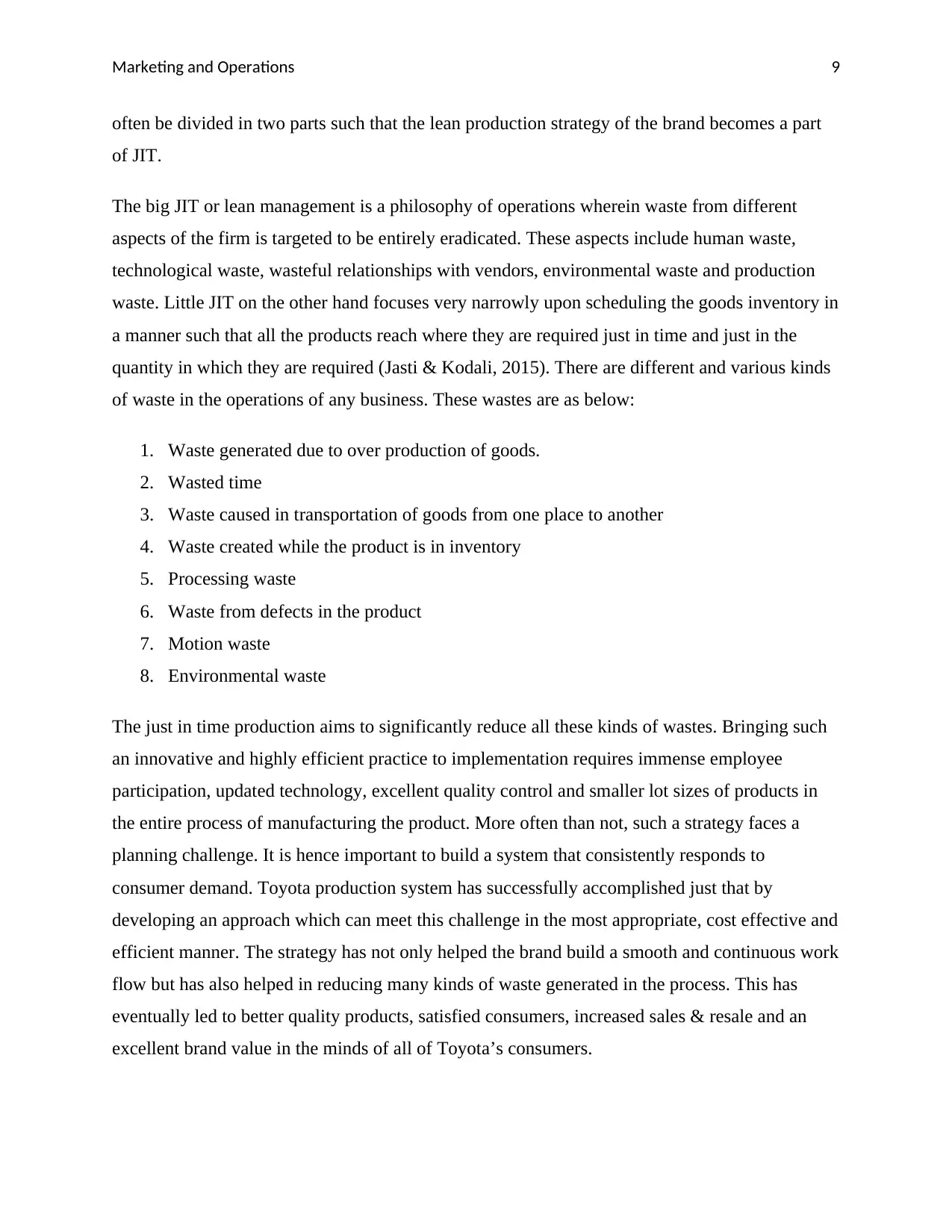
Marketing and Operations 9
often be divided in two parts such that the lean production strategy of the brand becomes a part
of JIT.
The big JIT or lean management is a philosophy of operations wherein waste from different
aspects of the firm is targeted to be entirely eradicated. These aspects include human waste,
technological waste, wasteful relationships with vendors, environmental waste and production
waste. Little JIT on the other hand focuses very narrowly upon scheduling the goods inventory in
a manner such that all the products reach where they are required just in time and just in the
quantity in which they are required (Jasti & Kodali, 2015). There are different and various kinds
of waste in the operations of any business. These wastes are as below:
1. Waste generated due to over production of goods.
2. Wasted time
3. Waste caused in transportation of goods from one place to another
4. Waste created while the product is in inventory
5. Processing waste
6. Waste from defects in the product
7. Motion waste
8. Environmental waste
The just in time production aims to significantly reduce all these kinds of wastes. Bringing such
an innovative and highly efficient practice to implementation requires immense employee
participation, updated technology, excellent quality control and smaller lot sizes of products in
the entire process of manufacturing the product. More often than not, such a strategy faces a
planning challenge. It is hence important to build a system that consistently responds to
consumer demand. Toyota production system has successfully accomplished just that by
developing an approach which can meet this challenge in the most appropriate, cost effective and
efficient manner. The strategy has not only helped the brand build a smooth and continuous work
flow but has also helped in reducing many kinds of waste generated in the process. This has
eventually led to better quality products, satisfied consumers, increased sales & resale and an
excellent brand value in the minds of all of Toyota’s consumers.
often be divided in two parts such that the lean production strategy of the brand becomes a part
of JIT.
The big JIT or lean management is a philosophy of operations wherein waste from different
aspects of the firm is targeted to be entirely eradicated. These aspects include human waste,
technological waste, wasteful relationships with vendors, environmental waste and production
waste. Little JIT on the other hand focuses very narrowly upon scheduling the goods inventory in
a manner such that all the products reach where they are required just in time and just in the
quantity in which they are required (Jasti & Kodali, 2015). There are different and various kinds
of waste in the operations of any business. These wastes are as below:
1. Waste generated due to over production of goods.
2. Wasted time
3. Waste caused in transportation of goods from one place to another
4. Waste created while the product is in inventory
5. Processing waste
6. Waste from defects in the product
7. Motion waste
8. Environmental waste
The just in time production aims to significantly reduce all these kinds of wastes. Bringing such
an innovative and highly efficient practice to implementation requires immense employee
participation, updated technology, excellent quality control and smaller lot sizes of products in
the entire process of manufacturing the product. More often than not, such a strategy faces a
planning challenge. It is hence important to build a system that consistently responds to
consumer demand. Toyota production system has successfully accomplished just that by
developing an approach which can meet this challenge in the most appropriate, cost effective and
efficient manner. The strategy has not only helped the brand build a smooth and continuous work
flow but has also helped in reducing many kinds of waste generated in the process. This has
eventually led to better quality products, satisfied consumers, increased sales & resale and an
excellent brand value in the minds of all of Toyota’s consumers.
Paraphrase This Document
Need a fresh take? Get an instant paraphrase of this document with our AI Paraphraser
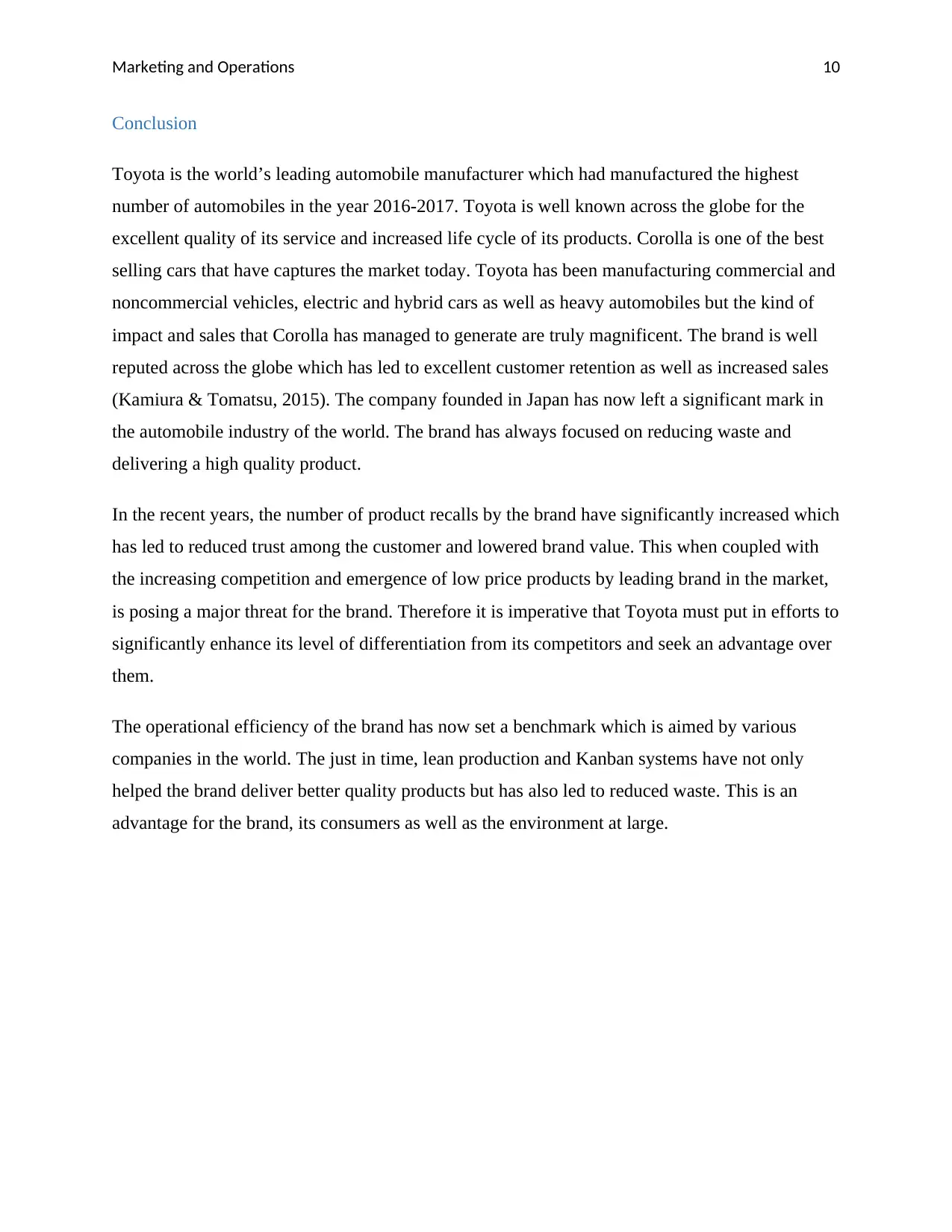
Marketing and Operations 10
Conclusion
Toyota is the world’s leading automobile manufacturer which had manufactured the highest
number of automobiles in the year 2016-2017. Toyota is well known across the globe for the
excellent quality of its service and increased life cycle of its products. Corolla is one of the best
selling cars that have captures the market today. Toyota has been manufacturing commercial and
noncommercial vehicles, electric and hybrid cars as well as heavy automobiles but the kind of
impact and sales that Corolla has managed to generate are truly magnificent. The brand is well
reputed across the globe which has led to excellent customer retention as well as increased sales
(Kamiura & Tomatsu, 2015). The company founded in Japan has now left a significant mark in
the automobile industry of the world. The brand has always focused on reducing waste and
delivering a high quality product.
In the recent years, the number of product recalls by the brand have significantly increased which
has led to reduced trust among the customer and lowered brand value. This when coupled with
the increasing competition and emergence of low price products by leading brand in the market,
is posing a major threat for the brand. Therefore it is imperative that Toyota must put in efforts to
significantly enhance its level of differentiation from its competitors and seek an advantage over
them.
The operational efficiency of the brand has now set a benchmark which is aimed by various
companies in the world. The just in time, lean production and Kanban systems have not only
helped the brand deliver better quality products but has also led to reduced waste. This is an
advantage for the brand, its consumers as well as the environment at large.
Conclusion
Toyota is the world’s leading automobile manufacturer which had manufactured the highest
number of automobiles in the year 2016-2017. Toyota is well known across the globe for the
excellent quality of its service and increased life cycle of its products. Corolla is one of the best
selling cars that have captures the market today. Toyota has been manufacturing commercial and
noncommercial vehicles, electric and hybrid cars as well as heavy automobiles but the kind of
impact and sales that Corolla has managed to generate are truly magnificent. The brand is well
reputed across the globe which has led to excellent customer retention as well as increased sales
(Kamiura & Tomatsu, 2015). The company founded in Japan has now left a significant mark in
the automobile industry of the world. The brand has always focused on reducing waste and
delivering a high quality product.
In the recent years, the number of product recalls by the brand have significantly increased which
has led to reduced trust among the customer and lowered brand value. This when coupled with
the increasing competition and emergence of low price products by leading brand in the market,
is posing a major threat for the brand. Therefore it is imperative that Toyota must put in efforts to
significantly enhance its level of differentiation from its competitors and seek an advantage over
them.
The operational efficiency of the brand has now set a benchmark which is aimed by various
companies in the world. The just in time, lean production and Kanban systems have not only
helped the brand deliver better quality products but has also led to reduced waste. This is an
advantage for the brand, its consumers as well as the environment at large.
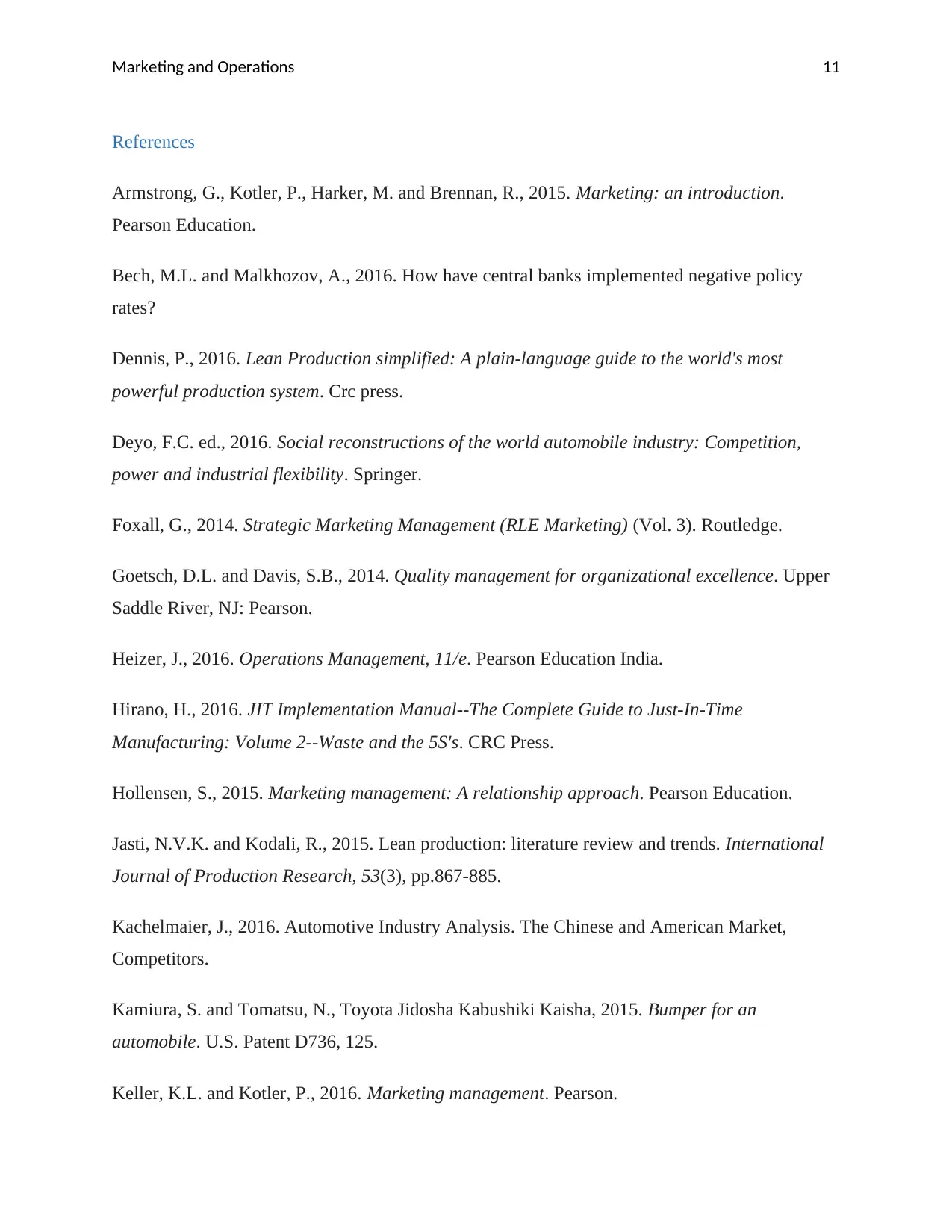
Marketing and Operations 11
References
Armstrong, G., Kotler, P., Harker, M. and Brennan, R., 2015. Marketing: an introduction.
Pearson Education.
Bech, M.L. and Malkhozov, A., 2016. How have central banks implemented negative policy
rates?
Dennis, P., 2016. Lean Production simplified: A plain-language guide to the world's most
powerful production system. Crc press.
Deyo, F.C. ed., 2016. Social reconstructions of the world automobile industry: Competition,
power and industrial flexibility. Springer.
Foxall, G., 2014. Strategic Marketing Management (RLE Marketing) (Vol. 3). Routledge.
Goetsch, D.L. and Davis, S.B., 2014. Quality management for organizational excellence. Upper
Saddle River, NJ: Pearson.
Heizer, J., 2016. Operations Management, 11/e. Pearson Education India.
Hirano, H., 2016. JIT Implementation Manual--The Complete Guide to Just-In-Time
Manufacturing: Volume 2--Waste and the 5S's. CRC Press.
Hollensen, S., 2015. Marketing management: A relationship approach. Pearson Education.
Jasti, N.V.K. and Kodali, R., 2015. Lean production: literature review and trends. International
Journal of Production Research, 53(3), pp.867-885.
Kachelmaier, J., 2016. Automotive Industry Analysis. The Chinese and American Market,
Competitors.
Kamiura, S. and Tomatsu, N., Toyota Jidosha Kabushiki Kaisha, 2015. Bumper for an
automobile. U.S. Patent D736, 125.
Keller, K.L. and Kotler, P., 2016. Marketing management. Pearson.
References
Armstrong, G., Kotler, P., Harker, M. and Brennan, R., 2015. Marketing: an introduction.
Pearson Education.
Bech, M.L. and Malkhozov, A., 2016. How have central banks implemented negative policy
rates?
Dennis, P., 2016. Lean Production simplified: A plain-language guide to the world's most
powerful production system. Crc press.
Deyo, F.C. ed., 2016. Social reconstructions of the world automobile industry: Competition,
power and industrial flexibility. Springer.
Foxall, G., 2014. Strategic Marketing Management (RLE Marketing) (Vol. 3). Routledge.
Goetsch, D.L. and Davis, S.B., 2014. Quality management for organizational excellence. Upper
Saddle River, NJ: Pearson.
Heizer, J., 2016. Operations Management, 11/e. Pearson Education India.
Hirano, H., 2016. JIT Implementation Manual--The Complete Guide to Just-In-Time
Manufacturing: Volume 2--Waste and the 5S's. CRC Press.
Hollensen, S., 2015. Marketing management: A relationship approach. Pearson Education.
Jasti, N.V.K. and Kodali, R., 2015. Lean production: literature review and trends. International
Journal of Production Research, 53(3), pp.867-885.
Kachelmaier, J., 2016. Automotive Industry Analysis. The Chinese and American Market,
Competitors.
Kamiura, S. and Tomatsu, N., Toyota Jidosha Kabushiki Kaisha, 2015. Bumper for an
automobile. U.S. Patent D736, 125.
Keller, K.L. and Kotler, P., 2016. Marketing management. Pearson.
⊘ This is a preview!⊘
Do you want full access?
Subscribe today to unlock all pages.

Trusted by 1+ million students worldwide
1 out of 13
Related Documents
Your All-in-One AI-Powered Toolkit for Academic Success.
+13062052269
info@desklib.com
Available 24*7 on WhatsApp / Email
![[object Object]](/_next/static/media/star-bottom.7253800d.svg)
Unlock your academic potential
Copyright © 2020–2025 A2Z Services. All Rights Reserved. Developed and managed by ZUCOL.




